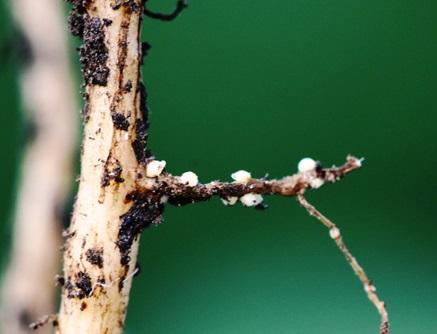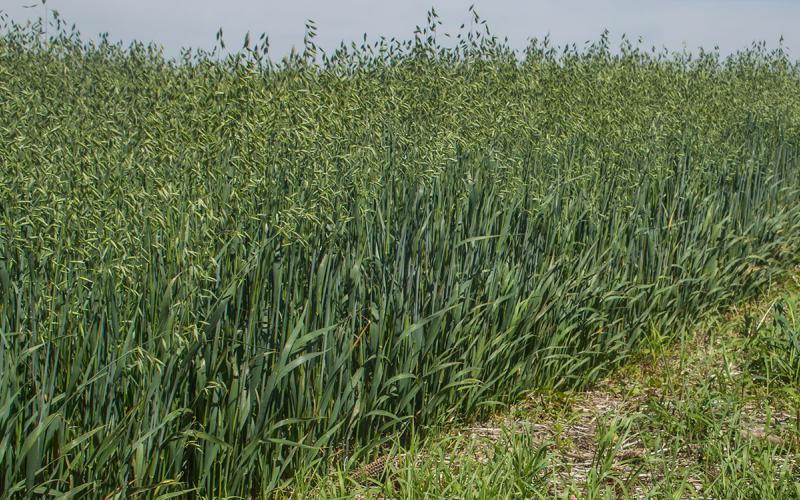Originally written with contributions by Emmanuel Byamukama, former SDSU Extension Plant Pathologist, and Febina Mathew.
Soybean cyst nematode (SCN) is the main soybean production constraint in South Dakota. Soybean plants can be infested with SCN but may not display visible symptoms. Up to 30% yield loss can occur without any obvious symptoms being seen. Also other symptoms that mimic SCN such as mineral deficiency, herbicide injury, and water logging make SCN diagnosis by foliar symptoms challenging. SCN impact on soybean yield is worse under hot, dry weather conditions.
Scouting

Scouting to determine the SCN status of soybean fields is the initial step in management. It is important to scout soybean for SCN even when no symptoms are being displayed. SCN symptoms, if present, include stunted plant growth, yellowing plants, and soybean rows with open and uneven canopy. There are two ways to determine the presence of SCN in a field: examining soybean roots and a soil test.
Scouting to determine the presence of SCN on soybean roots can be done by gently uprooting soybean plants and carefully examining the roots for female cysts (Figure 1). Use a shovel to dig up soybean plants and then gently remove the soil around the roots being careful to avoid stripping the cysts off the roots. Soybean plants at V5 have female cysts that are visible. However, if the SCN population is low, cysts on roots may be few and hence not easily seen. Cysts on roots are very small, the size of a period at the end of a sentence. Their color ranges from white to yellow to brown, depending on the age of the cyst.
Soil Testing
The most reliable way to determine if SCN exists in the soil is to do a soil test. A soil test can give an estimate of the SCN population density in the soil and it can also indicate if the SCN numbers are increasing or decreasing when done periodically. To obtain a soil sample for SCN testing, collect 20 soil cores 0-6” deep in a zig-zag pattern using a soil probe or a spade. Pay attention to field entrances, along fence lines, low spots, previously flooded areas, waterfowl activity areas, high pH areas, and low yielding/stunted portions of the field when collecting soil cores. The soil cores should be thoroughly mixed and put in a soil sample bag or a zipper top plastic bag. Larger fields should be divided into smaller portions between 10-20 acres and each portion sampled separately. Soil samples can be collected any time provided the soil is not frozen or too wet. The soil samples should be kept at room temperature or in a cooler until shipped to the SDSU Plant Diagnostic Clinic. There is no cost for SCN testing for South Dakota growers. SCN testing is sponsored by South Dakota Soybean Research and Promotion Council.
Management Considerations
The soybean cyst nematode is spread through soil movement. Anything that moves soil including farm machinery, water erosion, wind erosion, shoes, wildlife, and migratory birds will spread SCN from an infected field. Once detected in a field, it is practically impossible for SCN to be eradicated, partly because cysts can survive in the soil up to 10 years without a host and SCN is also highly prolific. It completes its life cycle every 24-30 days hence completing 3 cycles in a single growing season. One cyst can have over 300 eggs and hence in one season, one cyst can give rise to 27 million eggs. Therefore, one cyst is the threshold to start managing SCN.
SCN is best managed through an integrated approach to prevent the SCN numbers from building up. The first component is to rotate away from soybeans to non SCN hosts such as corn, alfalfa, small grains, flax, and canola. For highly infested soils, longer rotations out of soybeans for several years may be necessary to bring the SCN numbers down. The second component is to use resistant cultivars. Resistant cultivars play two roles: 1) they give high yield in SCN-infested soils and 2) they also prevent SCN numbers from increasing. The third approach is to rotate within soybean resistant cultivars. This ensures that SCN populations that can overcome a given resistance do not develop because of growing the same cultivar with the same source of resistance genes. Other practices that promote plant health like maintaining optimum fertility, weed control (especially SCN weed alternative hosts like pennycress and henbit), and proper drainage may increase soybean yield and limit damage by SCN. Several seed treatment products for managing SCN are available on the market but their effectiveness against SCN is not consistent.


